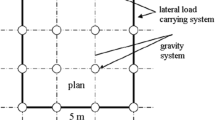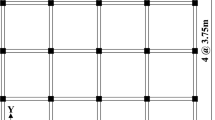Abstract
Tunnel-Form System (TFS) has become widely preferred, both for their ability to meet the increased housing demand due to the speed of construction and their high seismic performance. This underscores the importance of understanding TFS buildings’ behaviour during earthquakes. To obtain realistic responses under earthquake effects, Nonlinear Time History Analysis (NLTHA) is an effective method and, accordingly selection of appropriate Ground Motion (GM) and their scaling to a target design spectrum is one of the important steps of NLTHA. In this study, the seismic behavior of a TFS building was analyzed using three pairs of GMs scaled with Amplitude Scaling Method (ASM) and Spectrum Matching Method (SMM). Due to the considerably large stiffness matrices of the TFS buildings, NLTHA for that structure may require a significant amount of time and substantial data storage. To address this, the study investigates the potential for reducing analysis duration and data storage by shortening the records to their Significant Ground Motion (SGM) segment and comparing the results with those obtained with the original records. The analysis results indicate that the responses obtained with ASM exhibit greater variability compared to those obtained with SMM. Also, ASM yields greater responses than those for SMM and it is noteworthy that using GMs scaled with ASM is more conservative. Additionally, a comparison of results from the entire record and SGM segment has shown that using the SGM segment can significantly reduce analysis duration (60%) and the amount of data storage (70%) without substantially altering the responses.













Similar content being viewed by others
References
Abdul Hamid NH, Anuar S, Awang H, Effendi MK (2018). Seismic behavior of tunnel form building under lateral cyclic loading. Journal of Engineering & Technological Sciences, 50(2).
Altalabani D, Hejazi F, Rashid RSBM, Abd Aziz FNA (2021) Development of new rectangular rubber isolators for a tunnel-form structure subjected to seismic excitations. In structures, vol 32. Elsevier, pp 1522–1542
Armstrong RJ (2016) Procedure for selecting and modifying earthquake motions to multiple intensity measures. Soil Dyn Earthq Eng 89:91–99
Aval SBB, Asayesh MJ (2017) Seismic performance evaluation of asymmetric reinforced concrete tunnel form buildings. In structures, vol 10. Elsevier, pp 157–169
Baker JW (2011) Conditional mean spectrum: tool for ground-motion selection. J Struct Eng 137(3):322–331
Baker JW, Allin Cornell C (2006) Spectral shape, epsilon and record selection. Earthquake Eng Struct Dynam 35(9):1077–1095
Balkaya C, Kalkan E (2003) Estimation of fundamental periods of shear-wall dominant building structures. Earthquake Eng Struct Dynam 32(7):985–998
Balkaya C, Kalkan E (2004) Seismic vulnerability, behaviour and design of tunnel form building structures. Eng Struct 26(14):2081–2099
Balkaya C, Yuksel SB, Derinoz O (2012) Soil-structure interaction effects on the fundamental periods of the shear-wall dominant buildings. Struct Design Tall Spec Build 21(6):416–430
Balkaya C, Karagoz I, Gunal I (2017) Improving torsional rigidity and seismic performance of tunnel form building structures. Int J Eng Technol IJET 3(3):124–134
Balkaya C, Kalkan E (2002). Tünel Kalıp ile İnşa Edilen Yapıların Deprem Yükleri Altındaki Davranışları. ECAS2002 Uluslararası Yapı ve Deprem Mühendisliği Sempozyumu, Orta Doğu Teknik Üniversitesi, Ankara.
Behesthi Aval SB, Mohsenian V, SadeghKouhestani H (2018) Seismic performance-based assessment of tunnel form building subjected to near-and far-fault ground motions. Asian J Civ Eng 19:79–92
Bolt BA [1973] Duration of strong ground motions In: Proc. Fifth World Conference on Earthquake Engineering, Vol. 1, Rome, pp. 1304–1313.
Bommer JJ, Martínez-Pereira A (1999) The effective duration of earthquake strong motion. J Earthquake Eng 3(02):127–172
Bradley BA (2010) A generalized conditional intensity measure approach and holistic ground-motion selection. Earthquake Eng Struct Dynam 39(12):1321–1342
Cavdar E, Ozdemir G, Bayhan B (2019) Significance of ground motion scaling parameters on amplitude of scale factors and seismic response of short-and long-period structures. Earthq Spectra 35(4):1663–1688
CSI Analysis Reference Manual (2017) Computers and Structures Inc. Berkeley, CA, USA
Computers and Structures Inc. (2020) Sap2000 v21.2.0, Berkeley, CA, USA
Fahjan YM (2008) Türkiye deprem yönetmeliği (DBYBHY, 2007) tasarım ivme spektrumuna uygun gerçek deprem kayıtlarının seçilmesi ve ölçeklenmesi. Teknik Dergi 19(93):4423–4444
Ghafory-Ashtiany M, Mousavi M, Azarbakht A (2011) Strong ground motion record selection for the reliable prediction of the mean seismic collapse capacity of a structure group. Earthquake Eng Struct Dynam 40(6):691–708
Goel RK, Chopra AK (1998) Period formulas for concrete shear wall buildings. J Struct Eng 124(4):426–433
Gribniak V, Kaklauskas G, Idnurm S, Bačinskas D (2010) Finite element mesh size effect on deformation predictions of reinforced concrete bridge girder. Baltic J Road Br Eng 5(1):19–27
Hadzima-Nyarko M, Ademović N, Koković V, Lozančić S (2022) Structural dynamic properties of reinforced concrete tunnel form system buildings. In structures, vol 41. Elsevier, pp 657–667
Iervolino I, Galasso C, Cosenza E (2010) REXEL: computer aided record selection for code-based seismic structural analysis. Bull Earthq Eng 8:339–362
Katsanos EI, Sextos AG, Manolis GD (2010) Selection of earthquake ground motion records: a state-of-the-art review from a structural engineering perspective. Soil Dyn Earthq Eng 30(4):157–169
Krinitzsky EL, Chang FK (1977) State-of-the-art for assessing earthquake hazards in the United States: Report 7, Specifying peak motions for design earthquakes. Waterways experiment station.
Kurama YC, Farrow KT (2003) Ground motion scaling methods for different site conditions and structure characteristics. Earthquake Eng Struct Dynam 32(15):2425–2450
Lee LH, Chang KK, Chun YS (2000) Experimental formula for the fundamental period of RC buildings with shear-wall dominant systems. Struct Des Tall Build 9(4):295–307
Li J, **n H, Correia JA, Berto F, Zhao B, Bo Y, Veljkovic M (2022) Mesh size effects on fracture locus of high strength bolts: a mesoscale critical equivalent plastic strain (MCEPS) approach. Eng Fail Anal 138:106385
Lin T, Haselton CB, Baker JW (2013) Conditional spectrum-based ground motion selection. Part I: hazard consistency for risk-based assessments. Earthquake Eng Struct Dyn 42(12):1847–1865
Makarios T (2015) Design characteristic value of the arias intensity magnitude for artificial accelerograms compatible with Hellenic seismic hazard zones. Int J Innov Res Adv Eng 2(1):87–98
Mashayekhi M, Harati M, Darzi A, Estekanchi HE (2020) Incorporation of strong motion duration in incremental-based seismic assessments. Eng Struct 223:111144
Mohsenian V, Mortezaei A (2018) Seismic reliability evaluation of tunnel form (box-type) RC structures under the accidental torsion. Struct Concr 19(6):1927–1938
Mohsenian V, Mortezaei A (2019) New proposed drift limit states for box-type structural systems considering local and global damage indices. Adv Struct Eng 22(15):3352–3366
Mohsenian V, Nikkhoo A (2019) A study on the effects of vertical mass irregularity on seismic performance of tunnel-form structural system. Adv Concr Constr 7(3):131–141
Mohsenian V, Nikkhoo A, Hajirasouliha I (2019a) Estimation of seismic response parameters and capacity of irregular tunnel-form buildings. Bull Earthq Eng 17:5217–5239
Mohsenian V, Nikkhoo A, Hejazi F (2019b) An investigation into the effect of soil-foundation interaction on the seismic performance of tunnel-form buildings. Soil Dyn Earthq Eng 125:105747
Mohsenian V, Hajirasouliha I, Mariani S, Nikkhoo A (2020) Seismic reliability assessment of RC tunnel-form structures with geometric irregularities using a combined system approach. Soil Dyn Earthq Eng 139:106356
Mohsenian V, Gharaei-Moghaddam N, Hajirasouliha I (2021a) Seismic performance assessment of tunnel form concrete structures under earthquake sequences using endurance time analysis. J Build Eng 40(2021):102327
Mohsenian V, Nikkhoo A, Rostamkalaee S, Moghadam AS, Hejazi F (2021b) The seismic performance of tunnel-form buildings with a non-uniform in-plan mass distribution. In structures, vol 29. Elsevier, pp 993–1004
Mohsenian V, Nikkhoo A, Hajirasouliha I, Hejazi F (2022) A low computational cost seismic analyses framework for 3D tunnel-form building structures. Adv Struct Eng 25(14):2938–2952
Mohsenian V, Filizadeh R, Nikkhoo A, Hajirasouliha I (2023) Multi-level response modification factors for performance-based seismic design of tunnel-form building structures. J Earthquake Eng 27(15):4288–4305
Mortezaei A, Mohsenian V (2022) Reliability-based seismic assessment of multi-story box system buildings under the accidental torsion. J Earthquake Eng 26(2):674–697
Mousavi M, Ghafory-Ashtiany M, Azarbakht A (2011) A new indicator of elastic spectral shape for the reliable selection of ground motion records. Earthquake Eng Struct Dynam 40(12):1403–1416
Naseri SA, VaseghiAmiri J, Rajabnejad H, Sadeghi A (2022) A study into the effect of different ground motion durations on the seismic pounding force by considering soil–structure interaction. Asian J Civ Eng 23(1):53–65
Ozdemir Z, Fahjan YM (2007) Gerçek deprem kayıtlarının tasarım spektrumlarına uygun olarak zaman ve frekans tanım alanlarında ölçekleme yöntemlerinin karşılaştırılması. Altıncı Ulusal Deprem Mühendisliği Konferansı, İstanbul, 435–446.
PEER (2023) Pacific Earthquake Engineering Research Center. https://ngawest2.berkeley.edu/
Samanta A, Pandey P (2018) Effects of ground motion modification methods and ground motion duration on seismic performance of a 15-storied building. J Build Eng 15:14–25
Tavafoghi A, Eshghi S (2008) Seismic behaviour of tunnel form concrete building structures. In: The 14th World Conference on Earthquake Engineering (pp. 12–17).
Trifunac MD, Brady AG (1975) A study on the duration of strong earthquake ground motion. Bull Seismol Soc Am 65(3):581–626
Tsalouchidis KT, Adam C (2022) Amplitude scaling of ground motions as a potential source of bias: large-scale investigations on structural drifts. Earthquake Eng Struct Dynam 51(12):2904–2924
TSCB-2018. (2019) Turkish seismic code for buildings. Ankara, Turkey
Vanmarcke EH, Lai SSP (1977). Strong-motion duration of earthquakes. Massachusetts Inst. of Tech. Report.
Vanmarcke EH, Lai SSP (1980) Strong-motion duration and RMS amplitude of earthquake records. Bull Seismol Soc Am 70(4):1293–1307
Vanmarcke E (1979) State-of-the-art for assessing earthquake hazards in the United States: representation of earthquake ground motion: scaled accelerograms and equivalent response spectra. US Army Engineer Waterways Experiment Station.
Wang G, Zhang S, Zhou C (2015) Correlation between strong motion durations and damage measures of concrete gravity dams. Soil Dyn Earthq Eng 69:148–162
Yuksel SB, Kalkan E (2007) The behaviour of tunnel-form buildings under quasi-static cyclic lateral loading. Struct Eng Mech 27(1):99
Author information
Authors and Affiliations
Contributions
All authors contributed to the study conception and design. Material preparation, data collection and analysis were performed by Ismail TOZLU, and Muzaffer BOREKCI. The first draft of the manuscript was written by Ismail TOZLU and all authors commented on previous versions of the manuscript. All authors read and approved the final manuscript.
Corresponding author
Ethics declarations
Conflict of interest
The authors declare no competing interests.
Rights and permissions
Springer Nature or its licensor (e.g. a society or other partner) holds exclusive rights to this article under a publishing agreement with the author(s) or other rightsholder(s); author self-archiving of the accepted manuscript version of this article is solely governed by the terms of such publishing agreement and applicable law.
About this article
Cite this article
Tozlu, I., Borekci, M. The Impact of Scaling Methods and Strong Ground Motion Segments on the Seismic Behaviour of a Low-Rise Tunnel-Form System Building. Iran J Sci Technol Trans Civ Eng (2024). https://doi.org/10.1007/s40996-024-01451-4
Received:
Accepted:
Published:
DOI: https://doi.org/10.1007/s40996-024-01451-4




